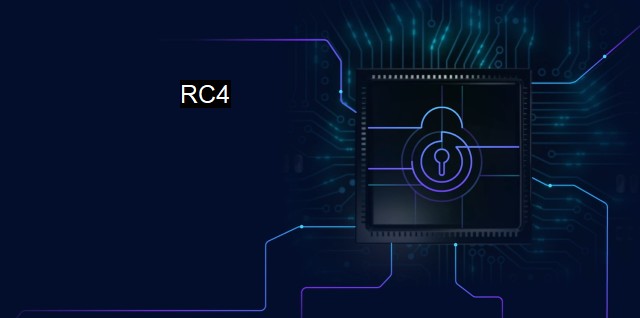What is RC4?
Exploring the Development, Vulnerabilities, and Future of RC4 Encryption: The Widely-Used Stream Cipher
RC4 is a pseudorandom number generator based stream cipher well-known for its simplicity and speed in software. Ronald Rivest of RSA Security Inc. invented it in 1987 for secure encryption. The RC stands for "Rivest Cipher," or occasionally, "Ron's Code." Though the company initially kept RC4 as a proprietary technology, its algorithm came into the public domain in September 1994.In the context of cybersecurity and antivirus software, RC4 played a crucial role due to its speed—one of the reasons why it became widely adopted in this field. Its use stretched from Secure Socket Layers (SSL) and Transport Layer Security (TLS) to Wired Equivalent Privacy (WEP) and Wi-Fi Protected Access (WPA).
The mechanism of operation for RC4 involves the generation of a keystream—a random string of bits that is applied via a bitwise XOR operation to plaintext, producing the resulting ciphertext. The encryption process involves combining the keystream with the data, converting plaintext data into a cryptic format, effectively making it incomprehensible to unauthorized individuals. Decryption, on the other hand, involves reapplying the same keystream to the ciphered text, thereby retrieving the original input data.
Despite the efficiency and initial popularity of RC4, it carries with it numerous vulnerabilities within its design that are liable to exploitation by cyber threat actors if not properly addressed. These susceptibilities range from weak keys, which become predictable patterns in the keystream, to ruled-based properties that exist regardless of the key.
The most prominent vulnerabilities discovered are the multiple ways of exploiting the biased outputs in the initial stream. FMS attack (Fluhrer, Martin and Shamir attack) utilized this fact to crack the Wired Equivalent Privacy (WEP) protocol. Later, the RC4 NOMORE attack exhibited an effective full plaintext recovery operation from WPA-TKIP networks using RC4 encryption.
Because of these weaknesses, many organizations like the Internet Engineering Task Force (IETF) and companies such as Microsoft issued advisories against the continued usage of RC4. It became deemed insecure for almost all new applications and protocols, including Transport Layer Security (TLS) and Secure Shell (SSH) as of 2015.
Despite RC4's shortcomings, its underlying principles continue to be foundational teaching tools in cryptography courses. By studying its architecture and vulnerabilities, researchers can better understand how to improve on existing algorithms and to design novel cryptographic solutions that significantly reduce susceptibility to cyber threats.
Over the years, the RC family of ciphers has grown, adding newer versions like RC2, RC5, RC6 - all variations that tried to build on and improve upon the existing methods, but each with their own unique vulnerabilities. The need for robust security measures and advanced cryptographic techniques is implicit in our current age of rapidly developing technology, where having secured data translates to robust operations whatever the context may be—in organizations, businesses, governments, or for personal use.
The tale of RC4 serves as a reminder of both the necessity and difficulty of designing perfect cryptosystems. It is a narrative of technology’s dialogue with the cyber threat landscape—one in which the development of a cipher heralds the eventual discovery of its flaws, necessitating advancement elsewhere. There is no panacea only continuous striving for better safeguards, operations, and understandings—ensuring that our most sensitive information remains securely out of reach.
Though RC4 is now considered outdated and insecure, it still holds historical significance in the world of cybersecurity. The lessons learned from its vulnerabilities have been instrumental in developing more robust encryption technologies that continue to protect sensitive data worldwide. As a catalyst for change, it marked the need for continued development and progression within the realm of encryption and cybersecurity. This continued commitment to fortification in cybersecurity will carry us forward into each increasing demand we face in this age of information.

RC4 FAQs
What is RC4 encryption algorithm?
RC4 encryption algorithm is a stream cipher developed in 1987 used for encryption and decryption of data. It is widely used in cybersecurity and antivirus software.How does RC4 encryption algorithm work?
RC4 encryption algorithm works by taking a key and generating a random stream of bytes. This stream is then XORed with the plaintext to produce the ciphertext. To decrypt the ciphertext, the same key is used to generate the same stream, which is again XORed with the ciphertext to produce the plaintext.What are the weaknesses of RC4 encryption algorithm?
RC4 encryption algorithm is vulnerable to several attacks, including the Fluhrer-Mantin-Shamir attack, the PTW attack, and the Bar-Mitzvah attack. These attacks can be used to recover the secret key used in the encryption algorithm, making it insecure.Is it safe to use RC4 encryption algorithm?
No, it is not safe to use RC4 encryption algorithm as it has several vulnerabilities that can be exploited by attackers. It is recommended to use more secure encryption algorithms like AES (Advanced Encryption Standard) that have been designed to be secure and resistant to attacks.Related Topics
Symmetric Encryption Stream Cipher Data Encryption Standard (DES) Advanced Encryption Standard (AES) Block Cipher
| | A | | | B | | | C | | | D | | | E | | | F | | | G | | | H | | | I | | | J | | | K | | | L | | | M | |
| | N | | | O | | | P | | | Q | | | R | | | S | | | T | | | U | | | V | | | W | | | X | | | Y | | | Z | |
| | 1 | | | 2 | | | 3 | | | 4 | | | 7 | | | 8 | | |||||||